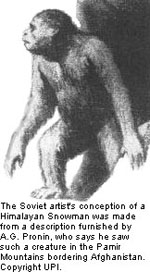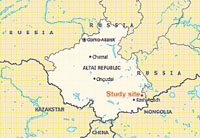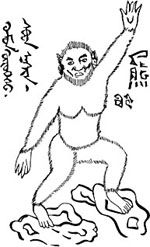
Almas, Mongolian for 'wild man, is the name given presumed hominid reputed to inhabit the Caucasus and Pamir Mountains of central Asia as well as the Altai Mountains of southern Mongolia. As is typical of the unknown hominids throughout central Asia, Russia, and the Caucasus, Almas are generally considered to be more akin to "wild people" in appearance and habits than an ape, unlike other hominids such as the Yeti of the Himalayas which is said to be more ape like than man.
Almas are typically described as human like bipedal creatures, between five and six and a half feet tall, their bodies are covered with reddish-brown hair, and they have anthropomorphic facial features including a pronounced brow-ridge, flat nose, and a weak chin. They are usually described as unclothed, although a handful of sightings refer to primitive clothing, made from animal skins, most likely used to keep warm. Many researchers have been struck by the similarity between descriptions of the Almas and modern reconstructions of how a Neanderthals might have appeared.  There is some evidence that would suggest the Almas may be more than a legendary creatures, mainly eyewitness accounts, footprint finds, and long standing native traditions, which have been documented over the years though investigations into the Almas. Almas appear in the legend of local people, who tell stories of sightings and interactions between villiages and Almas dating back several hundred years.
There is some evidence that would suggest the Almas may be more than a legendary creatures, mainly eyewitness accounts, footprint finds, and long standing native traditions, which have been documented over the years though investigations into the Almas. Almas appear in the legend of local people, who tell stories of sightings and interactions between villiages and Almas dating back several hundred years.
Some of these accounts describe primitive communication between the two parites via the use of hand gestures and exchange of goods. Drawings of Almas also appear in a Tibetan medicinal book, British anthropologist Myra Shackley noted that "The book contains thousands of illustrations of various classes of animals including reptiles, mammals and amphibia, but not one single mythological anima, like its medieval European counterparts which often listed many fantastic animals in its medical books. Being that every creature in the Tibetan medicnal book are well documented actualy species, with the exception of the Almas, gives some validity to the creatures existance.
Sightings recorded in writing go back as far back as the 15th century. In 1430, Hans Schildtberger, a bavarian nobleman recorded his personal observation of the Almas in a journal of his trip to Mongolia as a prisoner of the Mongol Khan. He chronicled the existence of these so called wild people who lived like animals and were allegedly covered with hair, with the notable exceptions of their hands and faces. Schiltberger himself encountered two of these beings himself after an unnamed warlord presented them as a gift to his captor.
Nikolai Przhevalsky observed the Almas in Mongolia in 1871, he noted that Almas are part of the Mongolian and Tibetan apothecary's materia medica, along with thousands of other animals and plants that still live today.
Between 1890 and 1928, Professor Tysben Zhamtsarano reportedly conducted research into the existence of the Almas but, as was too often the case in Stalin's Russia, the esteemed scientist was sent to a gulag and apparently his notes and illustrations, which detailed his numerous expeditions, a perished with him. Zhamtsarano's assistant, Dordji Meiren, even claimed to have seen an Almas skin, which was preserved in a Buddhist monastery near Mongolia's Gobi region.  1963 a man by the name of Ivan Ivlov's reportedly observed a whole family of Almas. Ivlov, a pediatrician, decided to interview some of the Mongolian children who were his patients and discovered that many of them had also seen and even interactied with the Almas. It seemed to Ivlov that neither the Mongol children nor the young Almas were afraid of each other.
1963 a man by the name of Ivan Ivlov's reportedly observed a whole family of Almas. Ivlov, a pediatrician, decided to interview some of the Mongolian children who were his patients and discovered that many of them had also seen and even interactied with the Almas. It seemed to Ivlov that neither the Mongol children nor the young Almas were afraid of each other.
There is a local legend about wild woman named Zana who is said to have lived in the isolated mountain village of T'khina, fifty miles from Sukhumi, Abkhazia in the Caucasus; some have speculated she may have been an Almas, but hard evidence is lacking. The legend says that she was captured in the mountains in 1850, at first she was violent towards her captors but soon became domesticated and, indeed, was able to assist with simple household chores. Zana is said to have had sexual relations with a man of the village named Edgi Genaba, and later gave birth to a number of children of apparently normal human appearance. Several of these children reportedly died in infancy, their deaths attributed to Zana's genetic incompatibility, as an Almas, with humans genetics. Zana herself is said to have died in 1890.
The legond continues to tell how the father, Edgi Genaba, gave away four of the surviving children to local families. The two boys, Dzhanda and Khwit Sabekia, born 1878 and 1884, and the two girls, Kodzhanar and Gamasa Sabekia, born 1880 and 1882, were assimilated into normal society, married, and had families of their own.. The skull of Khwit, the younger of the two boys. was examined by Dr. Grover Krantz in the early 1990s. He pronounced it to be entirely modern, with no Neandertal features at all. If Krantz's verdict on the skull is correct, and the skull itself is indeed that of Zana's son, it would indicate that Zana may have not been an Almas at all, but perhaps a member of an isolated hunter gatherer tribe so culturally different from her captors' society that it would make Zana seem non human to them, even though she was indeed a modern human.
Another case is said to date from around 1941, shortly after the German invasion of the USSR. A wild man was reportedly captured somewhere in the Caucasus by a detachment of the Red Army. He appeared human, but was covered in fine, dark hair. Interrogation revealed his apparent inability, or unwillingness, to speak, the wild man was later shot as a German spy. There are various versions of this encounter in the cryptozoological literature, and, as with other Almas reports, hard proof is absent.  Myra Shackley, a British anthropologist, and Bernard Heuvelmans, a renowned French cryptozoologist, have speculated that the Almas are a relict population of Neanderthals, while Loren Coleman, a well known figure head in the world of cryptozoology, suggests the the Almoas may be a surviving specimens of Homo erectus, or upright man. Still other researchers insist that Almas are related to the Yeti of the Himalayas, being closer to apes than to humans. The locals, for their part, often see no appreciable difference between Almas and humans, regarding them simply as "wild men" who remain untouched by civilization.
Myra Shackley, a British anthropologist, and Bernard Heuvelmans, a renowned French cryptozoologist, have speculated that the Almas are a relict population of Neanderthals, while Loren Coleman, a well known figure head in the world of cryptozoology, suggests the the Almoas may be a surviving specimens of Homo erectus, or upright man. Still other researchers insist that Almas are related to the Yeti of the Himalayas, being closer to apes than to humans. The locals, for their part, often see no appreciable difference between Almas and humans, regarding them simply as "wild men" who remain untouched by civilization.
Recently, controversy surrounding the Almas was rekindled , when in October of 2003, the BBC reported that mountain climber Sergey Semenov discovered the foot and leg of an unknown creature, approximately 3,500 meters up in the permafrost of the Altai Mountain range. Scientific tests and X-rays show that the bones are several thousand years old, but attempts to identify the creature they belonged to remain inconclusive. Upon further testing this mystery limb could very well be the best proof to date of the existence of hairy, bipedal humanoids in the Altai Mountains. And if the Almas can be proven as fact, its only matter of time before the worlds other mysterious hairy hominids are thrust into the spot light of science.
The Evidence
Despite a handful of sightings, footprint casts, and even photos that are debatable, no physical evidence of the Almas has been reported. This creature, like Bigfoot and other hominid cryptids will need to be captured or a body found in order to show it exists.
The Sightings
In 1420 the first known printed reference to the Almas was documented by Hans Schiiberger as he traveled through the Tien Shan mountains as a captive of the Mongols. During his imprisonment wrote the following in his journal:
“In the mountains themselves live a wild people, who have nothing in common with other human beings, a pelt covers the entire body of these creatures. Only the hands and face are free of hair. They run around in the hills like animals and eat foliage and grass what ever else they can find. The Lord of the territory made Egidi a present of a couple of forest people, a man and women, together with three untamed horses the size of asses and all sorts of other animals which are not found in German lands with I cannot therefore put a name to.”
In the mid 1850 a wild reddish-black hair covered woman with both human and Neanderthal features, dark skin, broad body, large hands and feet and a sloped forehead, was reportedly captured in the western Caucausus region of Abkhanzi, and given the name Zana. According to accounts, she was very physically powerful, able to perform feats of exceptional strength. While in captivity, Zana was passed on through a succession of owners, including noblemen, and also mothered several children. According to the legend she has as many as 6 offspring, by different men. Of these, the first 2 perished, due to Zana washing them in cold water after birth. The other 4 survived with the help of the local village women, who took care of the children. They were fairly normal, except for being dark and physically powerful, and grew up accepted among the villagers. Each of these children reportedly had children of their own.
In 1906 Badzare Baradyine, while on a caravan in the desert of Alachan, reports seeing a hairy man standing on the top of a sand dune, outlined against the sunset. After being approached by the Imperial Russian Geographical Society’s president and asked not to publish the encounter Baradyine reluctantly complied, but relays the information about his sighting to a personal friend, Mongolian professor Tsyben Zhamtsarano, who in turn begins a lengthy and determined investigation into the existence of the Almas.
1907 through 1940 Tsyben Zhamtsarano compiles eyewitness’ accounts and recruits an artist to draw the likeness of the Almas based on the gathered descriptions. He also plots sightings locations and dates on a map of the region. After being imprisoned in Russia for a number of years, the Zhamtsarano dies in 1940. His files vanish, and are rumored classified.
In 1937 Dordji Meiren, an associate of Professor Zhamtsarano, reports seeing a carpet made of out Almas hide being used in ritual ceremonies in a monastery.
In 1941 a Russian unit fighting the Germans in the Caucasus near Buinakst is asked by some partisans to look at an unusual prisoner. According to the unit’s commander, Lt. Col. Vargen Karapetyen, the captive man was naked, hairy and covered with lice, he obviously did not under stand speech and appeared to be dim witted, blinking often, the man was evidently afraid, but made no attempts to defend himself when Karapetyen pulled hairs from his body. The man was kept in a barn because inside in a headed room he smelt terrible and dripped sweat. Stories vary from that point, but they do agree that the prisoner was later executed as either a deserter or a German spy.
In 1957 Alexander Georgievitch Pronin, a hydrologist at the Geographical Research Institute of Leningrad University, sees a figure standing on a rocky cliff about 500 yards above him and the same distance away while on an expedition to the Pamir mountains for the purpose of mapping glaciers. Initially surprised by seeing someone at a known uninhabited area, Pronin subsequently realized that the creature was not human. It did resemble a man but “it was very stooped, with long forearms and covered in reddish grey hair”. Prorin reported seeing the creature again three days later, walking upright.
In 1963 Ivan Ivlon, a Russian pediatrician, sees a family of Almas consisting of a male, a female and a small child, standing on a mountain slope.
In 1964 Russian historian Boris Porshnev vists the place where Zana had reportedly lived. Several Centenarians claimed to have known her and to have attended her funeral. Doctor Porshnev also claimed to have meet a couple of Zana’s descendents and wrote the following:
“From the moment that I saw Zara’s Grandchildren, I was impressed by their dark skin and negroid looks. Shalikula, the grandson, has unusually powerful jaw muscles, and he can pick up a chair, with a man sitting in it, with his teeth.”
In 1972 an unnamed Russian doctor met a family of Almas, according to British anthropologist Myra Shackley, who adds that their “very simple lifestyle and the nature of their appereance suggests strongly that the Almas might represent the survival of a prehistoric way of life, and perhaps even of an earlier man.
In 1980 a worker at an experimental agricultural station operated by the Mongolian Academy of Sciences at Bulgan, encounters the dead body of a strange humanlike creature. He went on to describe the following:
“I approached and saw a hairy corpse of a robust humanlike creature dried and half buried by the sand. I had never seen such a humanlike being before covered by camel colored brownish yellow short hairs and I recoiled, although in my native land I had seen many dead men killed in battle… The dead thing was not a bear or ape and at the same time it was not a man like Mongol or Kazakh or Chinese and Russian. The hairs on its head where longer than on its body.”
In 1985 Maya Bykova, an assistant to Doctor Boris Porshnev, at Moscow’s Darwin Museum, is reported to have actually observed a humanoid of unknown identity, a creature nicknamed by the ethnic Mnasi people as Mecheny, which translates into marked, because of the whitish skin patch seen on its left forearm, the only part of its body not covered by reddish brown hair.
In 2003, the BBC reported that mountain climber Sergey Semenov discovered the foot and leg of an unknown creature, approximately 3,500 meters up in the permafrost of the Altai Mountain range. Scientific tests and X-rays show that the bones are several thousand years old, but attempts to identify the creature they belonged to remain inconclusive.
The Stats – (Where applicable)
• Classification: Hominid
• Size: Adults appear to be between 5 and 6 and half feet tall.
• Weight: Unknown
• Diet: Almas are most likely hunter gatherers which means there diet would consist of both local plant and animal life.
• Location: Caucasus and Pamir Mountains of central Asia as well as the Altai Mountains of southern Mongolia.
• Movement: Walking
• Environment: There are a wide variety of environments which encompass the areas said to be inhabited by the Almas, and it would appear that the creature can thrive in almost any of them.
|